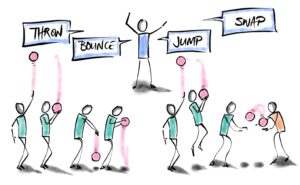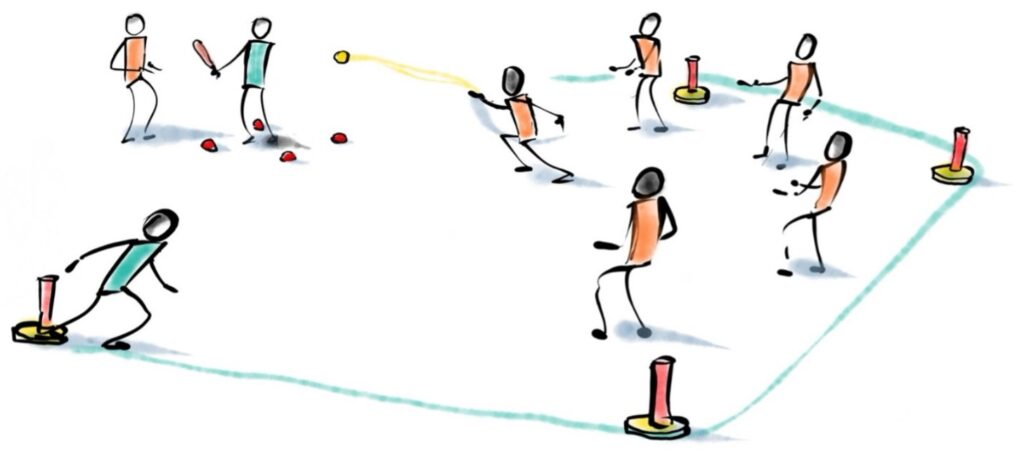Get lesson 1 of all sports: Sign up for a free pe planning membership
Rounders
Learning Objectives
- Choose skills that meet the needs of the situation.
- Show good awareness of others in game situations.
- Watch and evaluate the success of games.
Curriculum information
Literacy Keywords
- Bowling
- Batting
- Fielding
- Explore the game
- Experiment
- Run
Citizenship
- Develop self-confidence
- Develop own experiences and ideas
Numeracy
- Keep score of the game
- Counting
Equipment
- Balls
- Marker cones
- Bats
Risk Assessment
- Suitable clothing and footwear worn by participants.
- Equipment suitable for participants, safe and checked.
- Area safe and checked - any hazards removed.
- Safety information highlighted to participants.
- Staff aware of all emergency procedures, including designated 1st aider.
Knowledge Checks
Throughout this plan you will see ‘Knowledge Checks’ to help you ensure the pupils are acquiring the intended knowledge as the lesson progresses. The two types of knowledge to focus on in PE are:
- Declarative Knowledge: Factual knowledge concerning movement, rules, tactics, strategies, health and participation (best practiced through spoken or written observations of a practical demonstration).
- Procedural Knowledge: Knowing how to apply declarative facts (best practiced through demonstration or participation).
Teacher Notes
- This is the first lesson in the rounders Unit of Work. The intention of the lesson is to introduce the children to the new topic.
- It gives them the opportunity to experience the game and explore the skills they will be learning and developing in the unit.
- The main activity within the lesson incorporates many of the skills and tactics that will be covered in the unit.
- Playing the game in this lesson gives you the opportunity to make an initial assessment of your class.
- By observing the children you can make a judgement on their current ability and plan your teaching for the rest of the unit accordingly.
- Introduce the rounders bat to the children and ensure they are familiar with safety rules that go with using it:
- The bat should only be used and swung in the designated batting area.
- Only the batter should enter the batting area – nobody else should enter this area.
- Always be aware of who is around you when using a rounders bat. It should also be highlighted that if the rounders bat is not used safely and sensibly it could result in someone being hurt.
- Rounders is a striking and Fielding game where one team can score points when a player strikes a ball and runs to round the rounders pitch, while the other team attempts to retrieve the ball and return it to prevent their opponents from scoring.
Activities & Games
On or Under
3 - 5 mins- Split the class into two teams; the ‘On’s’ and the ‘Under’s’.
- In a large area, randomly spread out 30-40 cones. On half the cones place a tennis ball. And on the other half, place a tennis ball underneath the cone.
- The aim for the On’s is to have as many balls sat on top of the cones as possible.
- The aim for the Under’s is to have as many balls under the cones as possible.
- The two teams should start at opposite sides of the areas and on the signal ‘Go’ the game begins.
- Children must stay on their feet whilst playing, and can only touch one cone/ball at a time.
- Play the game for 30 to 60 seconds On the signal ‘Stop’ the children must stop playing the game and return to their side of the area.
- Count how many balls and cones each team has their way round – they get 1 point for each ball in the correct place for their team.
- Play the game again – asking teams to add up the score of both games at the end of the second game.
Teaching Points
- Head up to look where you are going.
- Take care not to bump into anyone.
- Move quickly to cones.
- Look where to move next.
- Bend knees to get low and turn cones over.

Command Ball
5 - 10 mins- Children work in a space on their own, with a tennis ball each.
- Ask pupils to move around the playing area, carrying their ball.
- Call out the following instructions for pupils to respond to:
– Throw – throw the ball in the air and catch it.
– Bounce – bounce the ball on the floor and catch it.
– Jump – throw their ball up and jump to catch it.
– Swap – find someone to swap balls with.
– Freestyle – perform a skill/challenge/trick with the ball, keeping the ball under control and close to their body.

Teaching Points
- Move into space.
- Change direction.
- Keep control of the ball.
- Use the correct technique.
- Listen carefully to instructions.
- Look for children performing skills well, and listening to commands quickly and reward.
To make activity harder:
- Challenge children to perform continuously until the command changes. Speed up the commands.
To make activity easier:
- Use a bigger ball. Allow the ball to bounce before catching. Ask children to only perform each command once before changing the instruction.
Knowledge Check
- PROCEDURAL KNOWLEDGE: Ask some children to demonstrate the activity/skill.
- DECLARATIVE KNOWLEDGE: Ask other children to describe what is required to perform the task with success.
Quick Rounders
25 - 30 mins- Allow the children to play the game, explore and experience the skills needed to play successfully.
- The game is played in groups of 6 or 8, each group requires a modified rounders pitch. Set up enough pitches for all teams to be playing.
- The pitch has 4 rounders bases for the runner to run around (with the last base being the return base for the fielders. Fielders need 1 bowler, 1 backstop, and 4 fielders inside the rounders square.
- Within their groups the children play the games in pairs – one pair bats, whilst the rest of the group fields.
- The aim of the game for the batting pair is to score as many points as possible – one child bats and the other is the runner.
- The batter hits the ball into the playing area, the runner runs around the bases scoring a point for each base they pass.
- The runner is not allowed to run if a fielder catches the ball before it bounces.
- The runner must stop running when a fielder returns the ball to the return base (last base).
- Each batter hits 3 shots and their partner scores as many points as they can for each shot.
- After 3 shots the batter and runner swap roles.
- The new batter then has 3 shots.
- The pair should keep their total score for the 6 shots.
- The children in the group should then swap roles so another pair bats.
- The game continues with all the pairs having a go at batting. The fielders take in turns to bowl. Bowlers must bowl good balls. Fielders must try to stop the batting pairs from scoring points.
- Although the fielder cannot run the batter out, they can stop them from scoring points by catching the ball before it bounces or quickly returning the ball to the return base (last base).

Teaching Points
- Introduction/reintroduction to rounders and striking and fielding games. What skills do you need to use? Ask the children to think about this as they play the game
- Experiment with different ideas and skills.
- How can you score points? Ask the children to think about this as they play the game.
- Observe children whilst playing the game – are they able to play it successfully?
- What areas do you need to focus your teaching on in the rest of the unit? Provide advice and guidance if necessary.
- SAFETY POINT: Use the rounders bat safely and sensibly
- Explain the rules and how the game works then let the children explore the game for themselves.
- Let the children have a go at the game.
Adaptations and variations:
- Run between bases that are closer together; hit the ball into a larger area; hit the ball off a tee; batter feeds the ball themselves (this will make it easier to score).
- Run between bases that are further apart; hit the ball into a smaller area; try to bowl the Batter out; play with a larger number of Fielders (this will make it harder to score).
- Use a positive scoring system, so that players are not rewarded for their opponent’s mistakes.
Throw, Clap, Catch
3 - 5 mins- Split the class into small groups of 4/5.
- Place a starting cone, one for each team, in a line at one side of the hall.
- In front of each starter cone, line 3 cones up at equal distances apart (approx. 2 metres).
- Pupils from each group line up behind their starter cone.
- The pupil at the front of the line needs a ball.
- The first pupil walks out, with their ball, to the first cone. They throw the ball in the air, clap one time before catching it and moving to the next cone.
- At the next cone, pupils throw the ball in the air and must clap twice before catching the ball and moving to the third cone.
- At the last cone, children must throw the ball in the air and clap 3 times before catching the ball.
- Once completed, children skip back to their team with the ball in their hand, passing it to the next pupil when they get back.

Teaching Points
- Move with head up – gradually decrease the speed and intensity of the activity.
- Watch the ball when throwing.
- If children are unsuccessful in catching, they must try once more before moving to the next cone.
Knowledge Check
What did you do well today?
- Encourage the children to think of what they have done well when playing the games.
What skills/areas can you improve on?
- Encourage the children to think of skills/areas of the game that they could work on to improve their performance.
Get lesson 1 of all sports: Sign up for a free pe planning membership